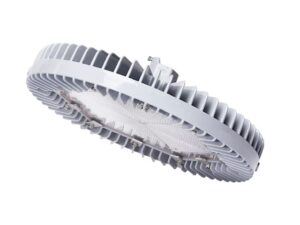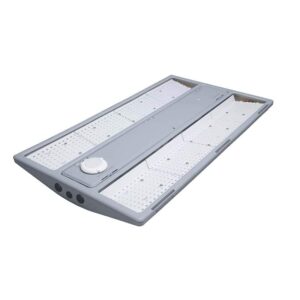When it comes time to choose your LED lighting, there are more options on the market now than ever before. Each manufacturer boasts the best product, but how can you tell which one is right for your application? Lumens per watt (LPW) is often how LED options are compared, but there are many other key performance factors that you should also consider. Our partners at Dialight have developed a white paper “Debunking the LPW Myth” to identify and assess key markers of industrial LED fixture quality.
What is LPW?
LED lighting is very efficient in terms of energy input vs. the light they produce, which is what LPW measures. Therefore, LPW is considered among the main performance factors to review for efficiency. However, when manufacturers only focus on improving the LPW, they often sacrifice other important factors.
Here is Dialight’s summary of what you should be including in your lighting selection discussions, and why there’s more to the story than just lumens per watt.
Optical Control & Comfort for LED Lighting
Secondary optics, often simply referred to as lenses, are important for protecting LEDs from environmental hazards. They also provide increased optical control and direct light where it needs to go. When manufacturers leave these out to focus purely on lumens per watt, the LEDs spray light at every angle, making them less efficient. Plus, the lack of protection or heat optimization means they can degrade more quickly. Secondary optics also help reduce glare, which improves the environment for workers so they can be more efficient. Every Dialight fixture includes carefully curated, high-quality LEDs and leverages advanced optics to direct light where it is needed without sacrificing visual comfort. By using precision optics, in many cases they can actually reduce the total amount of fixtures needed to light a space, which can translate to significant installation and operational cost savings.
LED Color Uniformity & Color Rendering
Another element that can affect LPW is the color of light. However, altering these just to change lumens per watt can take it outside of a color range that is comfortable for the human eyes, which can induce eyestrain or even alter how workers perceive colored signs, decreasing safety.
LED Fixture Size & Cost
When only energy efficiency is considered, the fixture itself can become much larger, making it more difficult for electricians to handle, which can add time and money to your maintenance and repair budget. Increased size also means that the fixture is too large to fit in many spaces.
Focus on More Than Just Lumens Per Watt
In the end, focusing on only LPW can cause a variety of unintended consequences that will not end up saving you the money you thought you’d gain through greater lighting efficiency. It may even create more headaches for you and your maintenance staff. When choosing an LED lighting partner, consider their engineering and testing standards, not just their efficiency. A well-designed LED fixture will be not only efficient, but also long-lasting and essentially maintenance-free. Dialight focuses on crafting lights ideally suited for industrial environments, that will work with the systems and components in place, stand up to the environment, and maintain their value across a long lifespan.
The Dialight Industrial LED Trifecta
Taking a holistic approach can make a greater impact on overall cost and customer satisfaction than LPW alone, which is why Dialight keeps the following goals at the forefront:
- Long Fixture Lifespan – Dialight fixtures are designed to be durable and virtually maintenance free.
- Optical Control and Light Quality – Dialight ensures their lights all have consistent quality of light and leverages optics to optimize the illumination of your space.
- Optimized Efficiency and Enhanced Savings – Dialight focuses on balancing performance, longevity, reliability and ROI.
Agilix Solutions offers a wide selection of Dialight LED lighting, and we can assist you in selecting the right solution for your particular application. You may browse Dialight products on our website, and reach out to your Account Manager with any questions you may have. You may also contact us online, or use our Live Chat feature in the bottom right corner of every page on our website to connect with a product specialist.


